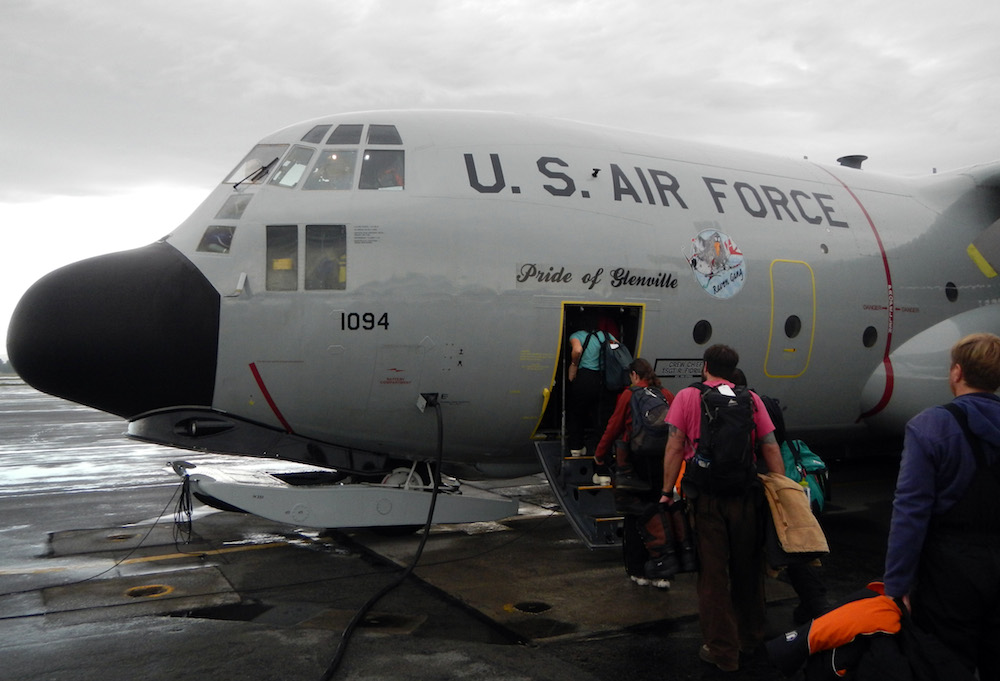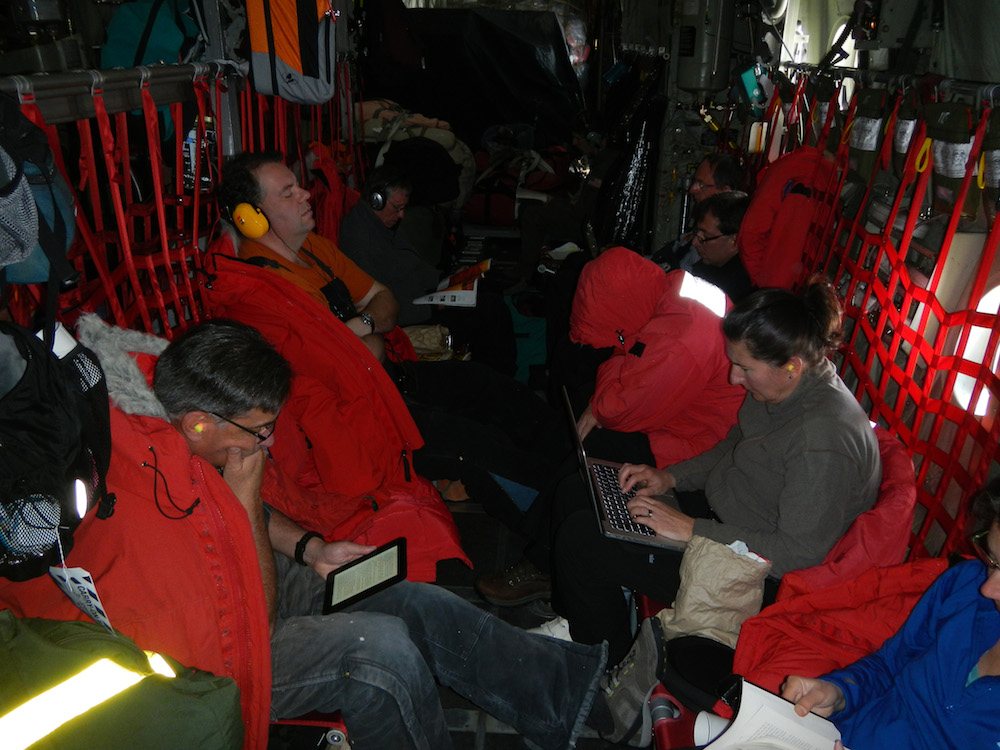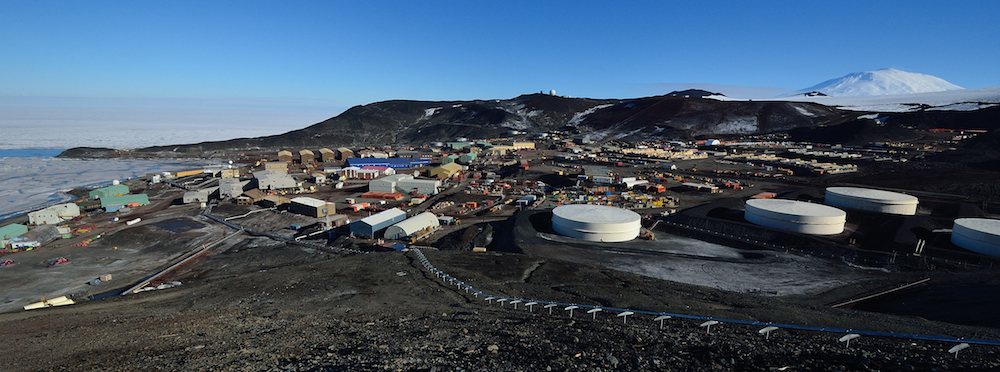9 January 2014
My flight to Antarctica left Christchurch, New Zealand Tuesday morning (7 January) at just after 9:30AM. For this trip I flew in a ski-equipped military cargo plane, known as an LC-130, operated by the US Air Force National Guard.
One of the crew members had a patch on his uniform that fit the holiday season.

My daughter Sabrina was very into the Grinch this year. I thought she would have been excited to see this patch.
The LC-130 is a loud and uncomfortable plane but for this trip it was less crowded than previous flights to Antarctica. The passengers (or should I refer to us as cargo?) sit on nylon webbing seats knee to knee with the person sitting across from us.
There are only a few windows so for the 8 hour flight to Antarctica we get to sit in our own world isolated from seeing the outside and unable to carry on any conversations due to the background noise of the plane. I did get a chance to go into the cockpit of the plane and was treated to a fantastic view of the mountains and glaciers of Antarctica.
Still, traveling to Antarctica by plane is faster and more comfortable than going by ice breaker, which takes more than a week and requires crossing the stormiest seas on the planet. On my one ice breaker trip (in December 1994) we encountered 25 foot seas during the crossing from Australia to Antarctica and that wasn’t even a stormy crossing.
Upon landing in Antarctica you step out of the plane onto an ice runway with large mountains on the horizon in every direction. The largest of these mountains is Mt. Erebus at over 12,000 feet tall. It is the southernmost active volcano in the world. The weather was decidedly un-Antarctic when I got off of the plane with blue skies and very warm (by Antarctic standards) temperatures in the mid-30s F. It was so warm that the snow surface was slushy and pools of meltwater dotted the the sides of the runway and snow road into McMurdo.
A bus, called Ivan the Terra Bus, with oversized tires to allow it to travel easily over soft snow, took us from the Pegasus ice runway to McMurdo Station. This 15 mile trip took almost 2 hours as the road wasn’t in very good shape due to the warm temperatures.
McMurdo Station is located on the bare volcanic rock of Ross Island in the shadow of Mt. Erebus. McMurdo isn’t the most attractive “town” and looks like a cross between a military base and a mining camp. Heavy equipment continually ply the roads moving cargo and people as dust swirls from the dry dirt roads in the Antarctic wind. Despite the less than glamorous appearance of McMurdo it almost feels like a second home to me. This is my 12th trip to McMurdo and I’m getting close to having spent a year of my life in here.
The town provides all of the services we need. There are several dormitory buildings, a large cafeteria (or galley), the science lab (where I’ll spend most of my time), garages and machine shops for repairing all of the equipment that keeps the US Antarctic Program running, cargo yards and warehouses, and even three bars and a general store.
Upon arriving in McMurdo we were ushered into an in-brief meeting where we were reminded of the details of life in McMurdo. We were then assigned rooms and had a chance to get a late dinner in the galley. I’m in dorm 155, which is in the same building as the cafeteria and general store. This dorm is typically used by people just passing through McMurdo and the rooms are setup to accommodate 4 people. I have two roommates – both working on a project that is drilling to the base of the West Antarctic ice sheet to better understand what causes the ice sheet to move.
For those of you that have followed my previous blog posts you know that one of my biggest complaints about McMurdo is the food and the fact that meals are served at set times every day. This year the galley is open 24 hours per day. Regular meals with a full menu are still offered at specific times each day but outside of normal meal times burgers, sandwiches, pizza, waffles, and an assortment of cold foods are available. I was also happy to see that the Frosty Boy ice cream machine is also still here and providing ice cream all day long.
I spent my first day and half, and will spend the next few days, completing training for everything from how to properly sort my trash to learning how to safely cross crevasses on the ice sheet. I’ll let you guess which of these I’ll pay the most attention to. Other training I’ll take will include a refresher on setting up a fieldcamp, snowmobile training, and even a class to discuss the dos and don’ts of recreational hiking around McMurdo.
I’ll also spend a lot of time in meetings with the various personnel on station that will help us complete our research. Melissa has done an excellent job making contact with the large number of people that we will work with so I was able to hit the ground running on my first morning in town.
We have also spent a lot of time getting our camp supplies. This included a visit to the Berg field center (BFC) which is the Antarctic equivalent of REI and visiting a large food room (the Antarctic version of a supermarket) where we got all of the food needed for our two week camping trip on the Ross Ice Shelf.
I suspect that I’ll be very busy with all of this and may not get a chance to post another blog entry before I leave for our field camp. Once I leave McMurdo I won’t have access to the internet so I won’t be updating this blog until I return around 27 January.
You can also follow Melissa’s blog at:
http://melissaontheice.blogspot.com/
and Dave’s blog at:
http://amrc.ssec.wisc.edu/blog/
Thanks for reading.
John







Nice Pics!!